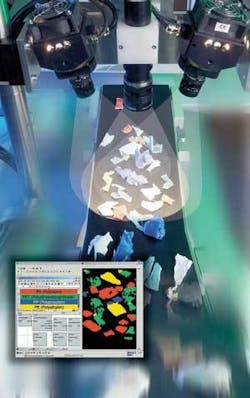Infrared imaging aids recycling
Custom software and IR imaging system team to sort consumer-waste packaging.
By Bob Grietens and Jouni Jussila
To facilitate the development of near-infrared (NIR) algorithms for waste sorting applications, Carinthian Tech Research has developed software for analyzing hyperspectral image data. By evaluating specific patterns on packaging containers, a classification system has been built that supports automatic waste classification and separation. The system, known as Spectrosort, separates waste paper, plastics, industrial waste, and fuels and is currently operating at a waste-recycling facility in Augsburg, Germany.
Spectrosort system is currently operated by a waste-recycling facility in Augsburg, Germany. A conveyor feeds the waste materials to be separated through a darkened compartment containing the NIR and visual measurement systems.
XenICs, a manufacturer of NIR components and cameras, worked with Spectral Imaging to develop a direct-sight NIR spectral camera for the system that is a combination of an ImSpector imaging spectrograph designed for the wavelength range 900-1700 nm and a monochromatic indium gallium arsenide (InGaAs) based matrix camera. It operates similarly to a linescan camera by capturing a line image of a target, but it disperses the light from each line image pixel to a spectrum. Each spectral image-that is, one frame from the camera-contains the spatial information from the imaged line pixels in spatial (horizontal) axis and the dispersed spectral information in spectral (vertical) axis. Using the camera, it is possible to acquire full spectral information for each line image acquired from the target (see Fig. 1).
Moving the object, or the spectral camera, and imaging the target sequentially line-by-line generates a three-dimensional spectral image. This is normally called a ‘data cube’ or ‘spectral cube’ and it contains, in addition to the typical 2-D image information, the full spectral information of each image pixel. According to the target’s spectral intensity distribution features, one or several wavelengths can be used to form a normal 2-D image of the target for classification or process-control purposes. This method, called spatial-resolved spectral analysis, also delivers image information and allows users to apply standard image-processing algorithms to the target analysis (see Fig. 2).
Typical applications are measurement of humidity, oil film or lacquer layer distributions, sorting of fruits and vegetables according to their ripeness, and separating polymers from natural materials. Spectral image-processing systems that perform these functions contain one or more cameras, spectrally matched illumination devices, a transport system, and the appropriate processing algorithms.
To analyze these spectral data as the information is transferred from the ImSpector camera to a PC, Carinthian Tech Research developed a universal toolbox called the Spectral Imaging Suite that consists of a structured spectral image-processing library and a graphical development and configuration environment. This software analyzes specific data patterns according to the Duales System Deutschland (DSD) waste-recycling standard. DSD is a nonprofit organization set up in Germany to collect and sort consumer-waste packaging.
Figure 2. Moving the object, or the camera, generates a three-dimensional spectral cube, where each pixel contains the full spectral information. A spectral cube also can be used to form a two-dimensional image of selected wavelengths for classification or process-control purposes.
By integrating an IR-based spectral camera and off-the shelf software, the Spectrosort system can be used to sort wastepaper, plastics, industrial waste, and fuels. Such a system, currently operated by the waste-recycling facility of the city of Augsburg, has a conveyor that feeds the waste materials to be separated through a darkened compartment containing the NIR and visual measurement systems (see image on p. 29).
Since longer-wavelength light penetrates deeply into the material, measurements are only slightly impacted by dirt and other surface effects such as imprints. Signal processors and computers analyze the objects and accordingly drive blowout valves to separate the materials at the end of the conveyor. In this way, recyclable materials such as paper, cardboard, and cardboard boxes can be separated and recycled.
Only the introduction of InGaAs as a detector material-which does not necessarily need cooling-allows NIR technology to be used up to a wavelength of 1.7 µm for industrial applications such as waste-recycling systems.
Bob Grietens is CEO, XenICs NV (Leuven, Belgium; www.xenics.com), and Jouni Jussila is product manager at Spectral Imaging Ltd. (Oulu, Finland; www.specim.fi).
Company Info
Carinthian Tech Research
St. Magdalen, Austria
www.ctr.at
Duales System Deutschland
Cologne, Germany
www.gruener-punkt.de
Spectral Imaging
Oulu, Finland
www.specim.fi
XenICs
Leuven, Belgium
www.xenics.com



